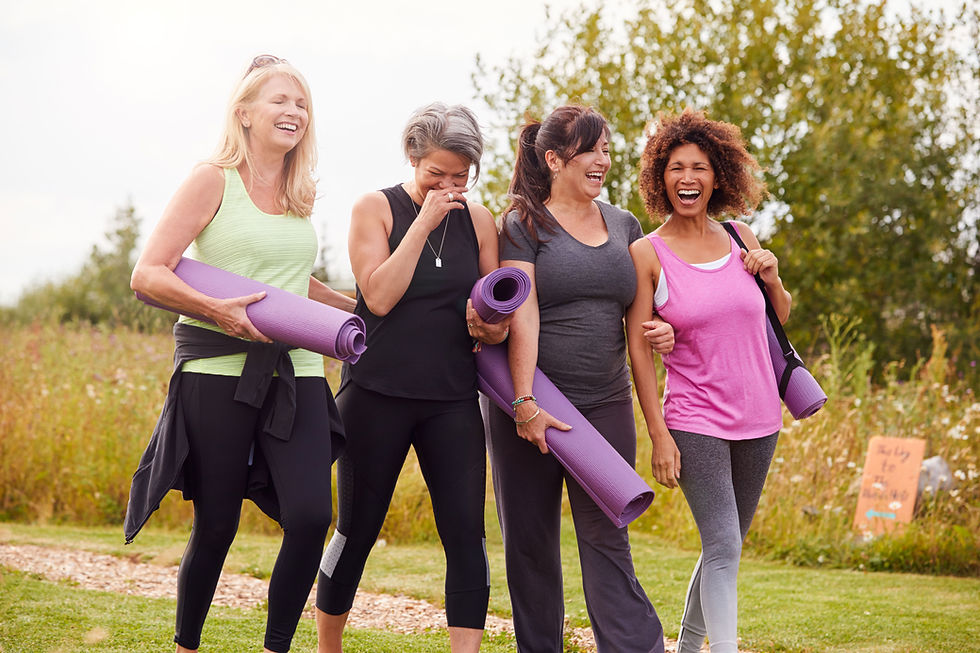Bite-Sized Yoga: Why 20 Minutes a Day Is All You Need
- ccmonnelly
- Jul 26, 2023
- 4 min read
Updated: Aug 6, 2023
Is 20 Minutes of Yoga a Day Enough?

Finding time for self-care can seem like a daunting and almost impossible task. But guess what? Even if you're swamped with a packed schedule, work and home responsibilities, and life in general, you can still get amazing benefits from just 20 minutes of yoga a day.
In this article, we're going to dive into the science-backed perks of a shorter but consistent yoga practice. Plus, we'll show you what a 20-minute session could look like and share some handy tips to make it a seamless part of your daily routine.
The Power of Consistency
So, let's talk about the power of being consistent. Sure, hour-long yoga sessions are can be fantastic. But squeezing in shorter sessions more often can be just as effective, if not better!
Often, finding a whole (uninterrupted) hour is completely unachievable. But a 20 minute session, or even two 10 minutes of practice, is a much more viable option, let's face it.

Studies have found that folks who do 20 minutes of yoga daily experience impressive improvements in flexibility, balance, and overall well-being compared to those who do it randomly or not at all. (Park et al., 2016)
And you know what? The American Heart Association is all about it too! They say that sticking to regular yoga brings in some long-term health benefits, like reduced stress, better focus, and emotional stability. Who wouldn't want that, right?
Benefits of a Shorter But Regular Yoga Practice
Stress Reduction
Even a brief yoga session can trigger the body's relaxation response, lowering cortisol levels and promoting a sense of calmness throughout the day
Improved Flexibility
Consistent stretching, even for 15-20 minutes a day, can gradually increase flexibility and reduce the risk of injuries
Enhanced Focus
Yoga encourages mindfulness and trains the mind to stay present, leading to improved concentration and mental clarity
Better Posture
Daily yoga helps strengthen core muscles and align the spine, leading to improved posture and reduced back pain
Increased Energy
Engaging in a short yoga practice can boost blood flow and oxygen circulation, leaving you feeling more energised and rejuvenated

What Does a 20-Minute Yoga Practice Look Like?
A 20-minute yoga practice can be tailored to suit your preferences and fitness level.
Here's a sample routine to get you started:
Start with a few minutes of deep breathing or meditation to centre your mind and set your intention for the practice
Warm-up: Begin with gentle neck and shoulder rolls, followed by spine stretches and simple standing poses like forward bends
Asanas (Yoga Poses): Focus on a few key poses, holding each for about 30 seconds to a minute. Consider incorporating the following: Downward Dog, Warrior II, Triangle Pose, and Child's Pose
Cool Down: End your session with a few relaxing poses like seated forward fold and finish with a couple of minutes of relaxation (Savasana)
"Take care of your body. It's the only place you have to live." - Jim Rohn
Practical Tips to Achieve 20 Minutes of Yoga Daily
Set a Schedule
Designate a specific time for your daily practice, whether it's early in the morning or during your lunch break.
Create a Sacred Space
Dedicate a quiet corner in your home for yoga, making it easier to step onto the mat daily.
Use Apps and Videos
There are numerous yoga apps and online tutorials that offer 20-minute sessions, making it convenient to follow along.

Be Realistic
If you're new to yoga, start with shorter sessions and gradually build up to 20 minutes as you become more comfortable.
Find a Yoga Buddy
Practicing with a friend or family member can help you stay motivated and accountable.
Conclusion
20 minutes of daily yoga is indeed enough to experience significant physical and mental benefits. The key lies in the consistency of your practice.
Embrace the shorter duration as a realistic approach to weaving yoga into your busy lifestyle.
Over time, you'll discover that these brief yet regular moments of self-care have a profound impact on your overall well-being and happiness. So, roll out your mat, take a deep breath, and embark on your journey to a healthier and more harmonious life!
References:
Park, C. L., Riley, K. E., & Bedesin, E. (2016). The effects of yoga on positive mental health among healthy adults: A systematic review and meta-analysis. The Journal of Alternative and Complementary Medicine, 22(9), 696-706. doi:10.1089/acm.2016.0140
Büssing, A., Michalsen, A., Khalsa, S. B., Telles, S., & Sherman, K. J. (2012). Effects of yoga on mental and physical health: A short summary of reviews. Evidence-Based Complementary and Alternative Medicine, 2012, 165410. doi:10.1155/2012/165410
The American Heart Association. (n.d.). Physical Activity Improves Quality of Life. Retrieved from https://www.heart.org/en/healthy-living/fitness/fitness-basics/physical-activity-improves-quality-of-life
Clay, C. C., Lloyd, L. K., Walker, J. L., & Sharp, K. R. (2005). The metabolic cost of hatha yoga. The Journal of Strength & Conditioning Research, 19(3), 604-610. doi:10.1519/14773.1
Sengupta, P. (2012). Health impacts of yoga and pranayama: A state-of-the-art review. International Journal of Preventive Medicine, 3(7), 444-458.
Tindle, H. A., Petzke, F. J., McClintock, M. K., & Buskirk, T. D. (2010). Yoga for fatigue: A pilot study of yoga of energy expenditure, respiratory effort, and ease of performing yoga poses. Complementary Therapies in Medicine, 18(5), 234-242. doi:10.1016/j.ctim.2010.07.004
Tindle, H. A., Stretch, M. R., Zhang, L., Shih, R. A., & VanderWeele, T. J. (2016). Daily yoga practice: A promising strategy for addressing health disparities among African Americans? Evidence-Based Complementary and Alternative Medicine, 2016, 1-8. doi:10.1155/2016/6239797




Comments